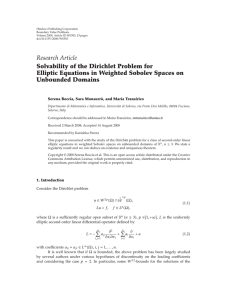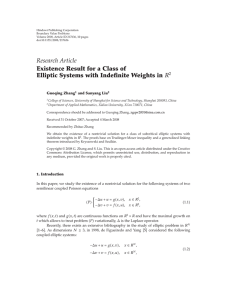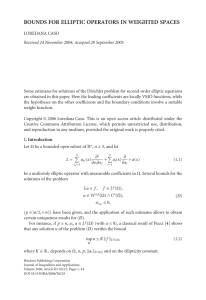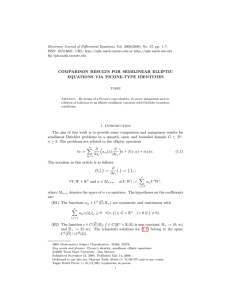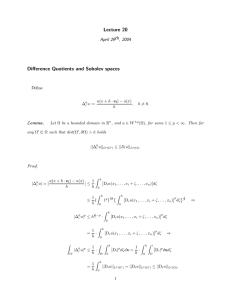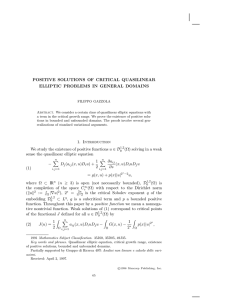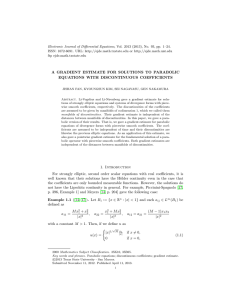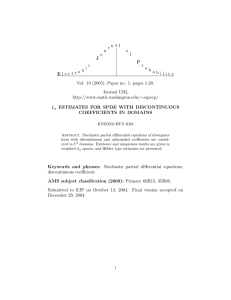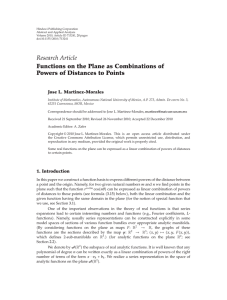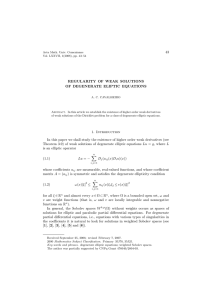Hindawi Publishing Corporation International Journal of Mathematics and Mathematical Sciences
advertisement
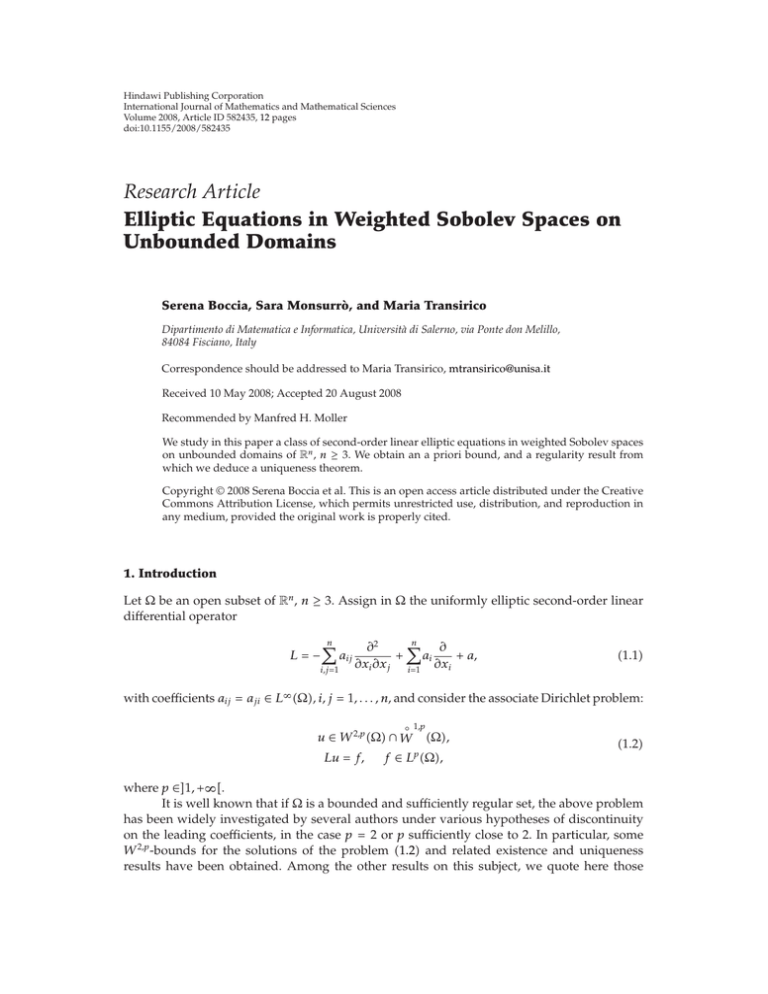
Hindawi Publishing Corporation
International Journal of Mathematics and Mathematical Sciences
Volume 2008, Article ID 582435, 12 pages
doi:10.1155/2008/582435
Research Article
Elliptic Equations in Weighted Sobolev Spaces on
Unbounded Domains
Serena Boccia, Sara Monsurrò, and Maria Transirico
Dipartimento di Matematica e Informatica, Università di Salerno, via Ponte don Melillo,
84084 Fisciano, Italy
Correspondence should be addressed to Maria Transirico, mtransirico@unisa.it
Received 10 May 2008; Accepted 20 August 2008
Recommended by Manfred H. Moller
We study in this paper a class of second-order linear elliptic equations in weighted Sobolev spaces
on unbounded domains of Rn , n ≥ 3. We obtain an a priori bound, and a regularity result from
which we deduce a uniqueness theorem.
Copyright q 2008 Serena Boccia et al. This is an open access article distributed under the Creative
Commons Attribution License, which permits unrestricted use, distribution, and reproduction in
any medium, provided the original work is properly cited.
1. Introduction
Let Ω be an open subset of Rn , n ≥ 3. Assign in Ω the uniformly elliptic second-order linear
differential operator
L−
n
aij
i,j1
n
∂2
∂
ai
a,
∂xi ∂xj i1 ∂xi
1.1
with coefficients aij aji ∈ L∞ Ω, i, j 1, . . . , n, and consider the associate Dirichlet problem:
◦ 1,p
u ∈ W 2,p Ω ∩ W
Lu f,
Ω,
f ∈ L Ω,
p
1.2
where p ∈1, ∞
.
It is well known that if Ω is a bounded and sufficiently regular set, the above problem
has been widely investigated by several authors under various hypotheses of discontinuity
on the leading coefficients, in the case p 2 or p sufficiently close to 2. In particular, some
W 2,p -bounds for the solutions of the problem 1.2 and related existence and uniqueness
results have been obtained. Among the other results on this subject, we quote here those
2
International Journal of Mathematics and Mathematical Sciences
proved in 1, where the author assumed that aij ’s belong to W 1,n Ω and considered the
case p 2 and in 2–4 where the coefficients belong to some classes wider than W 1,n Ω.
More recently, a relevant contribution has been given in 5–8, where the coefficients aij are
assumed to be in the class VMO and p ∈1, ∞
; observe here that VMO contains the space
W 1,n Ω.
If the set Ω is unbounded and regular enough, under assumptions similar to those
required in 1, problem 1.2 has for instance been studied in 9–11 with p 2, and in 12
with p ∈1, ∞
. Instead, in 13, 14 the leading coefficients satisfy restrictions similar to those
in 5, 6.
In this paper, we extend some results of 13, 14 to a weighted case. More precisely, we
denote by ρ a weight function belonging to a suitable class such that
lim ρx ∞,
infρ > 0,
Ω
|x|→∞
1.3
and consider the Dirichlet problem:
◦ 1,p
2,p
u ∈ Ws Ω ∩ W s Ω,
Lu f,
2,p
◦ 1,p
p
f ∈ Ls Ω,
1.4
p
where s ∈ R, Ws Ω, W s Ω, and Ls Ω are some weighted Sobolev spaces and the weight
functions are a suitable power of ρ. We obtain an a priori bound for the solutions of 1.4.
Moreover, we state a regularity result that allows us to deduce a uniqueness theorem for
the problem 1.4. A similar weighted case was studied in 15 with the leading coefficients
satisfying hypotheses of Miranda’s type and when p 2.
2. Weight functions and weighted spaces
Let G be any Lebesgue measurable subset of Rn and let ΣG be the collection of all Lebesgue
measurable subsets of G. If F ∈ ΣG, denote by |F| the Lebesgue measure of F, by χF the
characteristic function of F, by Fx, r the intersection F ∩ Bx, r x ∈ Rn , r ∈ R —where
Bx, r is the open ball of radius r centered at x—and by DF the class of restrictions to F of
functions ζ ∈ C◦∞ Rn with F ∩ supp ζ ⊆ F. Moreover, if XF is a space of functions defined
on F, we denote by Xloc F the class of all functions g : F → R, such that ζg ∈ XF for any
ζ ∈ DF.
We introduce a class of weight functions defined on an open subset Ω of Rn . Denote
by AΩ the set of all measurable functions ρ : Ω → R , such that
γ −1 ρy ≤ ρx ≤ γρy
∀y ∈ Ω, ∀x ∈ Ω y, ρy ,
2.1
where γ ∈ R is independent of x and y. Examples of functions in AΩ are the function
x ∈ Rn −→ 1 a|x|,
a ∈0, 1
,
2.2
and, if Ω /
Rn and S is a nonempty subset of ∂Ω, the function
x ∈ Ω −→ a dist x, S,
a ∈0, 1
.
2.3
Serena Boccia et al.
3
For ρ ∈ AΩ, we put
Sρ z ∈ ∂Ω : lim ρx 0 .
2.4
x→z
It is known that
ρ ∈ L∞
loc Ω,
ρ−1 ∈ L∞
loc Ω \ Sρ 2.5
see 16, 17.
We assign an unbounded open subset Ω of Rn .
Let ρ1 be a function, such that ρ1 ∈ ARn and
lim ρ1 x ∞.
infρ1 > 0,
Ω
2.6
|x|→∞
We put
ρ ρ1|Ω .
2.7
Ia x Ω x, aρ1 x .
2.8
For any a ∈0, 1 and x ∈ Rn , we set
k,p
If k ∈ N0 , 1 ≤ p < ∞, s ∈ R, and ρ ∈ AΩ, consider the space Ws Ω of distributions
u on Ω, such that ρs ∂α u ∈ Lp Ω for |α| ≤ k, equipped with the norm
uW k,p Ω s
ρs ∂α u p .
L Ω
2.9
|α|≤k
◦ k,p
k,p
0,p
p
Moreover, denote by W s Ω the closure of C◦∞ Ω in Ws Ω and put Ws Ω Ls Ω. A
more detailed account of properties of the above defined spaces can be found, for instance, in
18.
From 15, Lemmas 1.1 and 2.1, we deduce the following two lemmas, respectively.
p
p
Lemma 2.1. For any p ∈ 1, ∞
, s ∈ R, and a ∈0, 1, g ∈ Ls Ω if and only if g ∈ Lloc Ω and
s−n/p
the function x ∈ Rn → ρ1
such that
x||g||Lp Ia x belongs to Lp Rn . Moreover, there exist c1 , c2 ∈ R ,
p
c1 gLp Ω ≤
s
sp−n
Rn
ρ1
p
p
xgLp Ia x dx ≤ c2 gLp Ω
s
p
∀g ∈ Ls Ω,
2.10
where c1 and c2 depend on n, p, s, a, and ρ.
Lemma 2.2. If Ω has the segment property, then for any k ∈ N0 , p ∈ 1, ∞
, and s ∈ R one has
k,p
◦ k,p
◦ k,p
Ws Ω ∩ W loc Ω W s Ω.
2.11
4
International Journal of Mathematics and Mathematical Sciences
3. Some embedding lemmas
We now recall the definitions of the function spaces in which the coefficients of the operator
will be chosen. If Ω has the property
Ωx, r ≥ Ar n
∀x ∈ Ω, ∀r ∈0, 1,
3.1
where A is a positive constant independent of x and r, it is possible to consider the space
BMOΩ, τ τ ∈ R of functions g ∈ L1loc Ω such that
gBMO Ω,τ sup —
x∈Ω
r∈0,τ
where
—
Ωx,r
Ωx,r
g − —
−1
g Ωx, r
Ωx,r
g < ∞,
3.2
Ωx,r
g.
If g ∈ BMOΩ BMOΩ, τA , where
⎫
⎧
⎪
⎪
⎪
⎪
⎨
1⎬
rn
≤
τA sup τ ∈ R : sup
,
A⎪
⎪
⎪
⎪
x∈Ω Ωx, r
⎭
⎩
3.3
3.4
r∈0,τ
we will say that g ∈ VMOΩ if gBMOΩ,τ → 0 for τ → 0 . A function η
g : 0, 1 → R is
called a modulus of continuity of g in VMOΩ if
gBMO Ω,τ ≤ η
gτ ∀τ ∈0, 1, lim η
gτ 0.
τ→0
3.5
For t ∈ 1, ∞
and λ ∈ 0, n
, we denote by Mt,λ Ω the set of all functions g in Ltloc Ω such
that
gMt,λ Ω sup r −λ/t gLt Ωx,r < ∞,
3.6
r∈0,1
x∈Ω
endowed with the norm defined by 3.6. Then, we define M◦t,λ Ω as the closure of C◦∞ Ω in
Mt,λ Ω. In particular, we put Mt Ω Mt,0 Ω, and M◦t Ω M◦t,0 Ω. In order to define the
modulus of continuity of a function g in M◦t,λ Ω, recall first that for a function g ∈ Mt,λ Ω
the following characterization holds:
g ∈ M◦t,λ Ω ⇐⇒ lim pg τ 1 − ζ1/τ gMt,λ Ω 0,
τ→0
3.7
where
pg τ sup
E∈ΣΩ
supx∈Ω |Ex,1|≤τ
χE g t,λ ,
M Ω
τ ∈ R ,
3.8
Serena Boccia et al.
5
and ζr , r ∈ R , is a function in C◦∞ Rn such that
0 ≤ ζr ≤ 1,
ζr|Br 1,
supp ζr ⊂ B2r ,
3.9
with the position Br B0, r. Thus, the modulus of continuity of g ∈ M◦t,λ Ω is a function
σ◦ g : 0, 1 −→ R ,
3.10
such that
pg τ 1 − ζ1/τ g Mt,λ Ω ≤ σ◦ gτ ∀τ ∈0, 1, lim σ◦ gτ 0.
τ→0
3.11
A more detailed account of properties of the above defined function spaces can be found in
9, 19, 20.
We consider the following condition:
h0 Ω has the cone property, p ∈1, ∞
, s ∈ R, k, h, t are numbers such that
k ∈ N, h ∈ {0, 1, . . . , k − 1}, t ≥ p, t > p
if p n
, g ∈ Mt Ω.
k−h
3.12
From 21, Theorem 3.1 we have the following.
k,p
p
Lemma 3.1. If the assumption h0 holds, then for any u ∈ Ws Ω one has g∂h u ∈ Ls Ω and
h g∂ u p
≤ cgMt Ω uW k,p Ω ,
Ls Ω
3.13
s
with c dependent only on Ω, n, k, h, p, and t.
From 21, Theorem 3.2 it follows Lemma 3.2.
Lemma 3.2. If the assumption h0 is satisfied and in addition g ∈ M◦t Ω, then for any ε ∈ R there
exist a constant cε ∈ R and a bounded open set Ωε ⊂⊂ Ω, with the cone property, such that
h g∂ u
p
Ls Ω
≤ εuW k,p Ω cεuLp Ωε s
k,p
∀u ∈ Ws Ω,
3.14
where cε, Ωε depend on ε, Ω, n, k, h, p, t, ρ, s, and σ◦ g.
4. An a priori bound
Assume that Ω is an unbounded open subset of Rn , n ≥ 3, with the uniform C1,1 -regularity
property, and let ρ be the function defined by 2.7. Moreover, let p ∈1, ∞
and s ∈ R.
Consider in Ω the differential operator:
L−
n
aij
i,j1
n
∂2
∂
ai
a,
∂xi ∂xj i1 ∂xi
4.1
6
International Journal of Mathematics and Mathematical Sciences
with the following conditions on the coefficients:
h1 aij aji ∈ L∞ Ω ∩ VMOloc Ω, i, j 1, . . . , n,
n
aij ξi ξj ≥ ν|ξ|2 a.e. in Ω, ∀ξ ∈ Rn ,
∃ν > 0 :
4.2
i,j1
there exist functions eij , i, j 1, . . . , n, g and μ ∈ R such that
h2 eij eji ∈ L∞ Ω,
eij
n
xh
∈ M0t,n−t Ω,
eij ξi ξj ≥ μ|ξ|2
with t ∈2, n, i, j, h 1, . . . , n,
a.e. in Ω, ∀ξ ∈ Rn ,
i,j1
4.3
g ∈ L∞ Ω,
g0 ess inf g > 0,
Ω
n eij − gaij L∞ Ω\Br 0,
lim
r→∞
i,j1
h3 ai ∈ M◦t1 Ω,
aa a ,
a ∈
M◦t2 Ω,
i 1, . . . , n,
a ∈ L∞ Ω, ess inf a a0 > 0,
4.4
Ω
where
t1 ≥ n if p < n,
t1 > n
t2 ≥ n/2 if p < n/2,
t2 > n/2
if p n,
if p n/2,
t1 p
if p > n,
t2 p
if p > n/2.
4.5
Observe that under the assumptions h1 –h3 , it follows that the operator L :
2,p
p
Ws Ω → Ls Ω is bounded from Lemma 3.1.
Theorem 4.1. If the hypotheses h1 , h2 , and h3 are verified, then there exist a constant c ∈ R
and a bounded open subset Ω0 ⊂⊂ Ω, with the cone property, such that
uWs2,p Ω ≤ c LuLps Ω uLp Ω0 ,
2,p
◦ 1,p
∀u ∈ Ws Ω ∩ W s Ω,
4.6
with c and Ω0 depending on n, p, ρ, s, Ω, ν, μ, g0 , a0 , t, t1 , t2 , aij L∞ Ω , eij L∞ Ω , gL∞ Ω ,
a L∞ Ω , η
ζ2r0 aij , σ◦ eij x , σ◦ ai , σ◦ a , where r0 ∈ R depends on n, p, Ω, μ, g0 , a0 , t,
eij L∞ Ω , gL∞ Ω , a L∞ Ω , σ◦ eij x .
Proof. We consider a function φ ∈ C◦∞ Rn , such that
φ|B1/2 1, supp φ ⊂ B1 ,
sup∂α φ ≤ cα ∀α ∈ Nn0 ,
Rn
4.7
Serena Boccia et al.
7
where cα ∈ R depends only on α, fix y ∈ Rn and put
ψ ψy : x ∈ Rn −→ φ
x−y
.
ρ1 y
4.8
Clearly we have
ψ|By,1/2ρ1 y 1,
supp ψ ⊂ B y, ρ1 y ,
−|α|
sup∂α ψ ≤ cα ρ1 y ∀α ∈ Nn0 .
4.9
Rn
Now, we put
L0 −
n
aij
i,j1
∂2
∂xi ∂xj
4.10
◦ 1,p
2,p
◦ 1,p
and fix u ∈ Ws Ω ∩ W s Ω. Since ψu ∈ W 2,p Ω ∩ W Ω, from 14, Theorem 3.3, it
follows that there exist c1 ∈ R and a bounded open subset Ω1 ⊂⊂ Ω, with the cone property,
such that
ψuW 2,p Ω ≤ c1 L0 a ψuLp Ω ψuLp Ω1 ,
4.11
with c1 and Ω1 depending on n, p, Ω, ν, μ, g0 , a0 , t, aij L∞ Ω , eij L∞ Ω , gL∞ Ω , a L∞ Ω ,
η
ζ2r0 aij , σ◦ eij x , where r0 ∈ R depends on n, p, Ω, μ, g0 , a0 , t, eij L∞ Ω , gL∞ Ω ,
a L∞ Ω , σ◦ eij x . Since
L0 ψu ψL0 u − 2
n
aij ψxi uxj −
i,j1
n
aij ψxi xj u,
4.12
i,j1
from 4.11 and 4.12, we have
ψuW 2,p Ω
≤ c2
n n ψxi uxj Lp Ω ψxi xj u Lp Ω ψuLp Ω1 ,
ψ L0 a uLp Ω i,j1
4.13
i,j1
with c2 dependent on the same parameters of c1 .
On the other hand, since ρ ∈ L∞
Ω, we have that
loc
ψuLp Ω1 ≤ c3 ρ1−2 yuLp I1 y ,
4.14
where c3 ∈ R depends only on ρ.
Therefore, by 4.13 and 4.14, we deduce the bound:
uW 2,p I1/2 y ≤ ψuW 2,p Ω
≤ c4 L0 u a uLp I1 y ρ1−1 yux Lp I1 y ρ1−2 yuLp I1 y ,
where c4 ∈ R depends on the same parameters of c2 and on ρ.
4.15
8
International Journal of Mathematics and Mathematical Sciences
From 4.15 it follows
ps−n
Rn
ρ1
p
yuW 2,p I
≤ c5
ps−n
Rn
ρ1
1/2 y
dy
p
yL0 u a uLp I1 y dy
ps−n−p
Rn
ρ1
p
yux Lp I1 y dy ps−n−2p
Rn
ρ1
p
yuLp I1 y dy ,
4.16
where c5 ∈ R depends on the same parameters of c4 .
Since
p
p
p
Ls Ω → Ls−1 Ω,
p
Ls Ω → Ls−2 Ω,
4.17
from 4.16 and from Lemma 2.1 we have that
uWs2,p Ω ≤ c6 L0 u a uLps Ω ux Lp
s−1 Ω
uLps−2 Ω ,
4.18
with c6 ∈ R dependent on the same parameters of c5 and also on s.
Moreover, from Lemma 3.2 it follows that for any ε ∈ R , there exist c ε, c ε ∈ R ,
and two bounded open sets Ωε , Ωε ⊂⊂ Ω, both with the cone property, such that
ux p
L
s−1 Ω
uLps−2 Ω ≤ εuWs2,p Ω c εuLp Ωε ,
n
ai ux a u
i
i1
p
Ls Ω
≤ εuWs2,p Ω c εuLp Ωε ,
4.19
where c ε, Ωε depend on ε, Ω, n, p, ρ, s, and c ε, Ωε depend on ε, Ω, n, p, t1 , t2 , ρ, s, σ◦ ai ,
and σ◦ a .
From 4.18 and 4.19 it follows 4.6 and then we have the result.
5. A uniqueness result
In this section, we will prove our uniqueness theorem. We begin to prove a regularity result.
Lemma 5.1. Suppose that the assumptions h1 , h2 , and h3 (with t1 > n and t2 > n/2) hold, and
let u be a solution of the problem
2,q
◦ 1,q
p
u ∈ Wloc Ω ∩ W loc Ω ∩ Lm Ω,
p
Lu ∈ Ls Ω,
2,p
where q ∈1, p and m ∈ R. Then, u belongs to Ws Ω.
5.1
Serena Boccia et al.
9
Proof. By 13, Lemma 4.1 we have
◦ 1,p 2,p u ∈ Wloc Ω ∩ W loc Ω .
5.2
We choose r, r ∈ R , with r < r < 1, and a function φ ∈ C◦∞ Rn , such that
supp φ ⊂ Br ,
φ|Br 1,
α −|α|
∀α ∈ Nn0 ,
sup∂ φ ≤ cα r − r
5.3
Rn
where cα ∈ R depends only on α.
We fix y ∈ Rn and put
x−y
.
ψ ψy : x ∈ R −→ φ
ρ1 y
5.4
n
Clearly we have
ψ|By,rρ1 y 1,
supp ψ ⊂ B y, r ρ1 y ,
−|α|
−|α|
∀α ∈ Nn .
sup∂α ψ ≤ cα ρ y r − r
5.5
0
1
Rn
◦ 1,p
Since ψu ∈ W 2,p Ω∩ W Ω, from 14, Theorem 3.3 it follows that there exist c1 ∈ R
and a bounded open subset Ω1 ⊂⊂ Ω, with the cone property, such that
ψuW 2,p Ω ≤ c1 LψuLp Ω ψuLp Ω1 ,
5.6
with c1 and Ω1 depending on n, p, Ω, ν, μ, g0 , a0 , t, t1 , t2 , aij L∞ Ω , eij L∞ Ω , gL∞ Ω ,
a L∞ Ω , η
ζ2r0 aij , σ◦ eij x , σ◦ ai , σ◦ a , where r0 ∈ R depends on n, p, Ω, μ, g0 , a0 , t,
eij L∞ Ω , gL∞ Ω , a L∞ Ω , σ◦ eij x .
Since
Lψu −
n
aij ψuxi xj i,j1
ψLu − 2
n
n
i1
ai ψuxi aψu
n
n
aij ψxi u xj aij ψxi xj u ai ψxi u,
i,j1
i,j1
5.7
i1
from 5.6 and 5.7, we have
ψuW 2,p Ω
≤ c2
n ψx u ψLuLp Ω i
xj
i,j1
Lp Ω
n n ψxi xj u Lp Ω ai ψxi u Lp Ω ψuLp Ω1 ,
i,j1
i1
5.8
with c2 dependent on the same parameters of c1 .
10
International Journal of Mathematics and Mathematical Sciences
From Lemma 3.1 with s 0, we have that
ai ψx u p
≤ c3 ai Mt1 Ω ψxi uLp Ω ψxi u x Lp Ω ,
i
L Ω
5.9
with c3 dependent on Ω, n, p, and t1 .
Using 22, Corollary 4.5, we can obtain the following interpolation estimate:
ψx u p ψx u xj
i
i
L Ω
Lp Ω
1/2
1/2 ≤ c4 ψxi u xx Lp Ω ψxi uLp Ω ψxi uLp Ω ,
5.10
where the constant c4 depends on Ω, n, p.
Thus, by 5.8–5.10, with easy computations, we deduce the bound:
−2
uW 2,p Ir y ≤ ψuW 2,p Ω ≤ c5 r − r
−1
1/2
× LuLp Ir y u1/2
ρ1−1 yuLp Ir y ,
ρ1 yuLp Ir y
W 2,p I y
r
5.11
where c5 ∈ R depends on n, p, ρ, Ω, ν, μ, g0 , a0 , t, t1 , t2 , aij L∞ Ω , eij L∞ Ω , gL∞ Ω ,
a L∞ Ω , η
ζ2r0 aij , σ◦ eij x , ai Mt1 Ω , σ◦ ai , σ◦ a .
By a well-known lemma of monotonicity of Miranda see 23, Lemma 3.1, it follows
from 5.11 that
1/2
u1/2
uW 2,p I1/2 y ≤ c6 LuLp I1 y ρ1−1 yuLp I1 y ρ1−1 yuLp I1 y
W 2,p I
1/2 y
,
5.12
and then, using Young’s inequality, we deduce from 5.12 that
uW 2,p I1/2 y ≤ c7 LuLp I1 y ρ1−1 yuLp I1 y ,
5.13
with c6 , c7 ∈ R dependent on the same parameters of c5 .
From 5.13 it follows
ps−n
p
ρ1 yuW 2,p I y dy
1/2
Rn
≤ c8
Rn
ps−n
p
ρ1 yLuLp I1 y dy
Rn
ps−n−p
p
ρ1
yuLp I1 y dy
5.14
,
where c8 ∈ R depends on the same parameters of c7 .
If m ≥ s − 1, since
p
p
Lm Ω → Ls−1 Ω,
5.15
from 5.14 and from Lemma 2.1 we have that
uWs2,p Ω ≤ c9 LuLps Ω uLp
s−1 Ω
,
5.16
with c9 ∈ R dependent on the same parameters of c8 and on s. Therefore, u belongs to
2,p
Ws Ω.
Serena Boccia et al.
11
If m < s − 1, we denote by k the positive integer, such that
s − m − 1 ≤ k < s − m.
5.17
Then, for i 1, . . . , k, we have that
p
p
Ls Ω → Lmi Ω.
5.18
Therefore, using 5.14 and 5.16 with m i, i 1, . . . , k, instead of s, we deduce that u ∈
2,p
2,p
Wm1 Ω, . . . , u ∈ Wmk Ω. On the other hand, we have that
2,p
p
Wmk Ω → Ls−1 Ω
p
5.19
2,p
and then, since u ∈ Ls−1 Ω, 5.14 holds. Thus, u satisfies 5.16 and then u ∈ Ws Ω.
Theorem 5.2. If conditions h1 , h2 , and h3 (with t1 > n and t2 > n/2) hold, and a ≥ a0 > 0 a.e.
in Ω, then the problem
2,p
◦ 1,p
u ∈ Ws Ω ∩ W s Ω,
Lu 0,
5.20
admits only the zero solution.
2,p
◦ 1,p
Proof. Fix u ∈ Ws Ω ∩ W s Ω, such that Lu 0. From Lemma 5.1 it follows that u ∈
◦ 1,p
W 2,p Ω. On the other hand, since u ∈ W 1,p Ω ∩ W loc Ω, from Lemma 2.2 we have that
◦ 1,p
u∈ W
Ω. Thus, from 13, Theorem 5.2 we deduce that u 0.
References
1 C. Miranda, “Sulle equazioni ellittiche del secondo ordine di tipo non variazionale, a coefficienti
discontinui,” Annali di Matematica Pura ed Applicata, vol. 63, no. 1, pp. 353–386, 1963.
2 A. Alvino and G. Trombetti, “Second order elliptic equations whose coefficients have their first
derivatives weakly-Ln ,” Annali di Matematica Pura ed Applicata, vol. 138, no. 1, pp. 331–340, 1984.
3 M. Chicco, “Dirichlet problem for a class of linear second order elliptic partial differential equations
with discontinuous coefficients,” Annali di Matematica Pura ed Applicata, vol. 92, no. 1, pp. 13–22, 1972.
4 M. Franciosi and N. Fusco, “W 2,p regularity for the solutions of elliptic nondivergence form equations
with rough coefficients,” Ricerche di Matematica, vol. 38, no. 1, pp. 93–106, 1989.
5 F. Chiarenza, M. Frasca, and P. Longo, “Interior W 2,p estimates for nondivergence elliptic equations
with discontinuous coefficients,” Ricerche di Matematica, vol. 40, no. 1, pp. 149–168, 1991.
6 F. Chiarenza, M. Frasca, and P. Longo, “W 2,p -solvability of the Dirichlet problem for nondivergence
elliptic equations with VMO coefficients,” Transactions of the American Mathematical Society, vol. 336,
no. 2, pp. 841–853, 1993.
7 C. Vitanza, “W 2,p -regularity for a class of elliptic second order equations with discontinuous
coefficients,” Le Matematiche, vol. 47, no. 1, pp. 177–186, 1992.
8 C. Vitanza, “A new contribution to the W 2,p regularity for a class of elliptic second order equations
with discontinuous coefficients,” Le Matematiche, vol. 48, no. 2, pp. 287–296, 1993.
9 M. Transirico and M. Troisi, “Equazioni ellittiche del secondo ordine di tipo non variazionale in aperti
non limitati,” Annali di Matematica Pura ed Applicata, vol. 152, pp. 209–226, 1988.
10 M. Transirico and M. Troisi, “Ulteriori contributi allo studio delle equazioni ellittiche del secondo
ordine in aperti non limitati,” Bollettino della Unione Matematica Italiana. Serie VII. B, vol. 4, no. 3, pp.
679–691, 1990.
12
International Journal of Mathematics and Mathematical Sciences
11 L. Caso, P. Cavaliere, and M. Transirico, “Existence results for elliptic equations,” Journal of
Mathematical Analysis and Applications, vol. 274, no. 2, pp. 554–563, 2002.
12 L. Caso, P. Cavaliere, and M. Transirico, “Solvability of the Dirichlet problem in W 2,p for elliptic
equations with discontinuous coefficients in unbounded domains,” Le Matematiche, vol. 57, no. 2,
pp. 287–302, 2002.
13 L. Caso, P. Cavaliere, and M. Transirico, “Uniqueness results for elliptic equations VMO-coefficients,”
International Journal of Pure and Applied Mathematics, vol. 13, no. 4, pp. 499–512, 2004.
14 L. Caso, P. Cavaliere, and M. Transirico, “An existence result for elliptic equations with VMOcoefficients,” Journal of Mathematical Analysis and Applications, vol. 325, no. 2, pp. 1095–1102, 2007.
15 P. Di Gironimo and M. Transirico, “Second order elliptic equations in weighted Sobolev spaces on
unbounded domains,” Rendiconti della Accademia Nazionale delle Scienze detta dei XL. Serie V. Memorie
di Matematica, vol. 15, no. 1, pp. 163–176, 1991.
16 L. Caso and M. Transirico, “Some remarks on a class of weight functions,” Commentationes
Mathematicae Universitatis Carolinae, vol. 37, no. 3, pp. 469–477, 1996.
17 M. Troisi, “Su una classe di funzioni peso,” Rendiconti della Accademia Nazionale delle Scienze detta dei
XL. Serie V. Memorie di Matematica, vol. 10, no. 1, pp. 141–152, 1986.
18 M. Troisi, “Su una classe di spazi di Sobolev con peso,” Rendiconti della Accademia Nazionale delle
Scienze detta dei XL. Serie V. Memorie di Matematica, vol. 10, no. 1, pp. 177–189, 1986.
19 M. Transirico, M. Troisi, and A. Vitolo, “Spaces of Morrey type and elliptic equations in divergence
form on unbounded domains,” Bollettino della Unione Matematica Italiana. Serie VII. B, vol. 9, no. 1, pp.
153–174, 1995.
20 M. Transirico, M. Troisi, and A. Vitolo, “BMO spaces on domains of Rn ,” Ricerche di Matematica, vol.
45, no. 2, pp. 355–378, 1996.
21 A. V. Glushak, M. Transirico, and M. Troisi, “Teoremi di immersione ed equazioni ellittiche in aperti
non limitati,” Rendiconti di Matematica e delle sue Applicazioni, vol. 9, no. 1, pp. 113–130, 1989.
22 S. Boccia and L. Caso, “Interpolation inequalities in weighted Sobolev spaces,” to appear in Journal of
Mathematical Inequalities.
23 C. Miranda, “Teoremi di unicità in domini non limitati e teoremi di Liouville per le soluzioni dei
problemi al contorno relativi alle equazioni ellittiche,” Annali di Matematica Pura ed Applicata, vol. 59,
no. 1, pp. 189–212, 1962.
